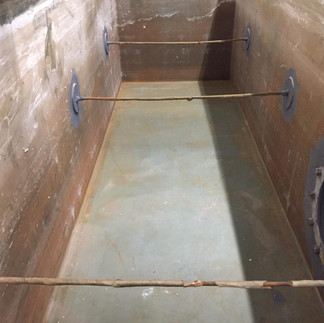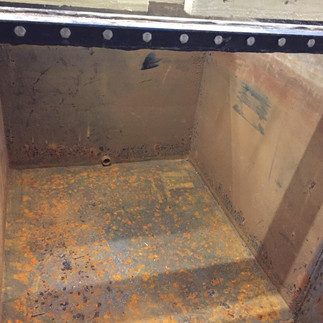In this latest blog post, we'll delve into the detailed scope of our recent relining works on two steel flume water storage tanks and one GRP flume water storage tank. In this project, our primary focus was to deliver a new steel water tank lining, utilising the innovative Tank Reline 165 DWPU solution. Join us as we take you through the step-by-step process and highlight the benefits of this specialist solution for aging water tanks.
Steel Water Tank Lining - Project Overview
We embarked on the task of preparing and relining two steel flume water storage tanks at a University, referred to as the Reynolds Channel tank (Steel - 9.25m x 1.25m x 1.25m) and the Reynolds Flume tank (Steel - 2m x 1.4m x 1.25m). Additionally, we worked on relining one GRP flume water storage tank, known as the Kelvin Channel tank (GRP - 10.05m x 1.1m x 1.03m). Our objective was to ensure the tanks were effectively relined using the Tank Reline 165 DWPU product, ultimately optimising their performance and extending their lifespan. Upon completion, the tanks were refilled, checked for leaks, disinfected and recommissioned by our team.
The pictures below display all three tanks upon being drained, highlighting the corrosion and deterioration that had occurred over time.
Steel Water Tank Lining Methodology
Arrival: To commence the project, the client drained down the tanks before the arrival of our skilled Titan Mechanical Services operatives. Ensuring a safe and efficient working environment was paramount.
Surface Preparation: Thorough surface preparation was performed to guarantee a robust and long-lasting lining. Our team diligently tightened all accessible bolts and assessed mastic joints, diligently repairing any areas that required attention. Subsequently, all surfaces underwent abrasion to achieve a surface profile of approximately 75 microns. This critical step prepared the tanks for optimal coating adhesion.
Application of Stripe Coat: To create a seamless membrane and reinforce high-risk areas, our team applied the Stripe Coat using brushes. This additional layer was applied to joints, edges, bolt heads, struts, and any sharp protuberances. The Stripe Coat served as an extra safeguard, ensuring maximum durability and protection. The images below highlight all three tanks following these stages.
Application of First Coat: Using rollers, the first coat of the Tank Reline 165 DWPU solution was applied to all internal surfaces. Our skilled operatives diligently worked to achieve a minimum wet film thickness of 500 microns. This coat significantly contributed to the overall integrity of the steel water tank.
Application of Second Coat: Similar to the first coat, the second coat was expertly applied to all internal surfaces using rollers. The aim was to achieve a minimum wet film thickness of 500 microns, ultimately resulting in a desired total coating thickness of 1000 microns across all internal surfaces. This second application ensured a robust and long-lasting lining.
Re-commissioning: Upon successful completion of the lining works, the tanks were refilled, we checked for any potential leaks, carried out a disinfection process and recommissioned all three into use. This re-commissioning marked the completion of the project, with our clients receiving a 10-year guarantee as standard

























Comments